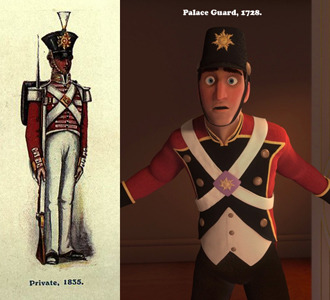I've noticed a lot of people responding to my Frozen/Tangled debunking with some variant of "But it must have taken place in at least 1790/1890/1828 because it has Mozart/tandem bicycles/cupcakes!" and I wanted to address how this approach to dating fictional works is misguided.
Quite simply, it is making the mistake of dating fiction the way you would date actual historical documents. In real life, any single item may provide a minimum date because that item would have to exist in the real world in order to appear. So, a historic photo with a single item from 100 years later than the rest of the material would definitively date it to at least the later time period (i.e., meaning it's a fake). However, the same does not hold true for fiction, because we already know it's a fake...that's what fiction means! In fiction, it is more correct to take the overall appearance of the work and the predominant themes of costume, architecture, technology, and trappings to set a time period that the author probably intended. Remember we're looking for *intent* here, rather than when something actually happened (if we're looking for items to definitively date something in reality, that's trivially easy: Tangled is from 2010 and Frozen is from 2013).
Another little wrinkle that is particularly relevant for dramatic works is that costumes don't just set the time and place; they are also important for establishing the function of the characters. This is especially relevant to the guards in Tangled, who for a lot of people seem to set it in the 1800s:


From findingcorona.tumblr.com
The most important thing about the guard's costumes is that they need the audience to understand that these are guards, and they are a legitimate threat to Flynn Rider. That might not be as easy to communicate to the audience when the actual guard uniform of the day was something like this:

And even the armored guards have to strike a balance between their more medieval-looking armored breastplates and a more streamlined, regimented look from later centuries, because it's hard for modern audiences to consider these pants much of a menace:

A costume designer is going to have to balance being faithful to the setting with having the audience understand who this person is and what role they play in the story, along with other things like status...for instance, how the head guard has epaulets so that we instantly understand that he is of higher status than the rest, even though epaulets don't really fit the time period.
So, with all that it mind, I give you...
Satiricalifragilistic's Comprehensive Hierarchy of Dating Historical Periods in Drama
- The costumes of the main characters--the story is focused on them, after all. The caveat of course is if any particular character has some reason to be anachronistic or stand out from the rest. Elsa's icy dress would be a good example of when this rule doesn't hold true.
- The costumes of background characters. These should be your bread-and-butter, but sometimes they are too simplified to be of much help. Also, with characters like the peasants in Tangled, European pauper fashion really didn't change that much over several centuries.
- The architecture.
- Technology in general--this is lower than the other determinants because it is far too easy for a creator to throw something in without too much thought. That said, technology in toto can be a useful indicator of authorial intent.
- The costume of any character with a specific purpose or profession. See above.
- A single item or piece of technology: even more likely to be a one-off.
- Anything in a song. Lots of liberties get taken to preserve the meter or to communicate ideas quickly.
- Anything said by a character who breaks the 4th wall.
- Anything part of a comedic gag or Easter egg.
Therefore, it isn't valid to hold up one prop or gag and say this definitively dates a fictional universe: it's more likely the modern author made a mistake or took liberties to convey an idea quickly to the audience. However, if two worlds on the whole look NOTHING alike and have numerous continuous stylistic choices placing them in different centuries, then that's very good evidence that the creators did not mean for these two worlds to have any contemporal connection.

No comments:
Post a Comment